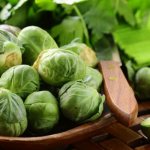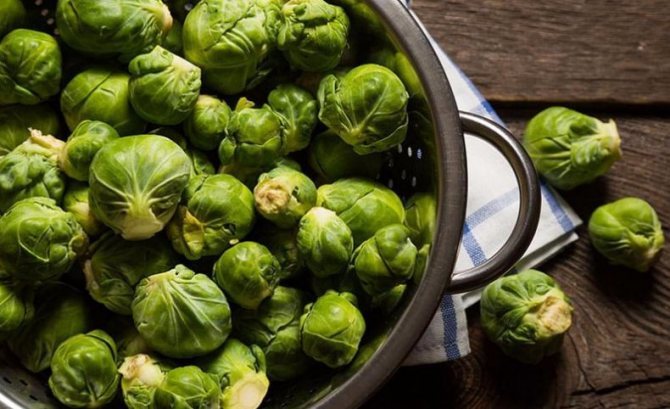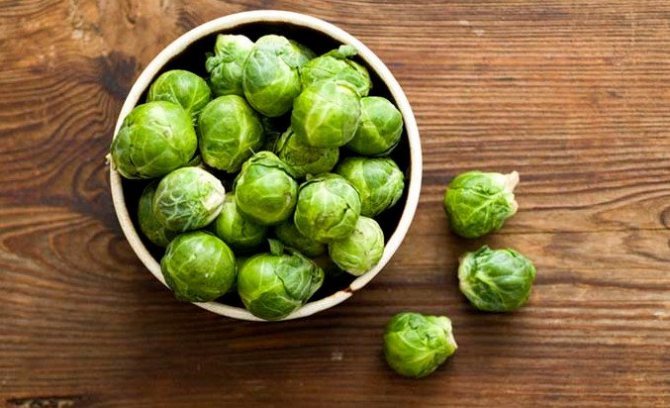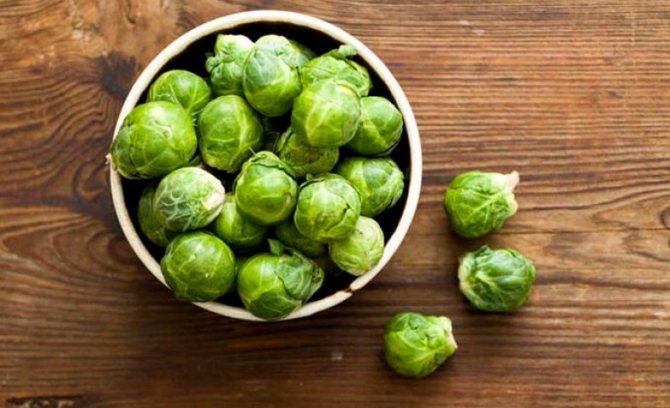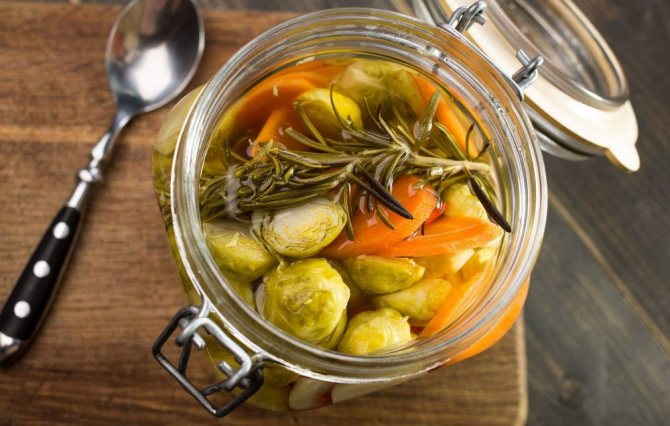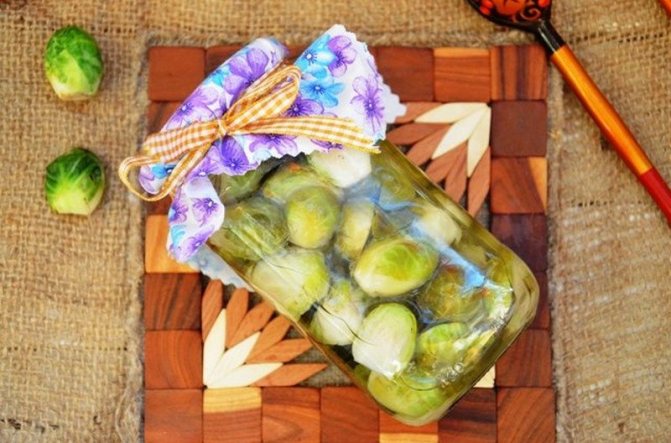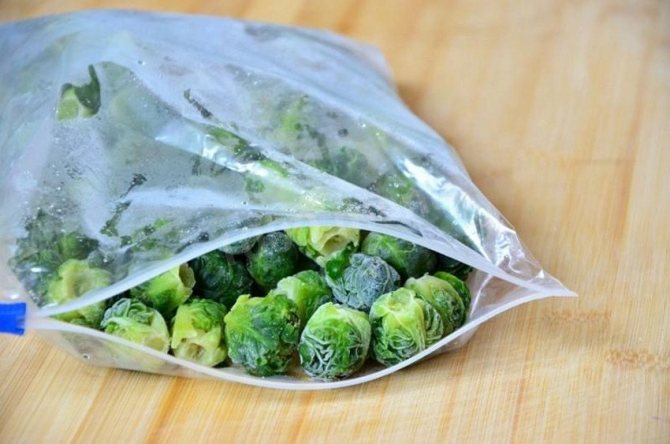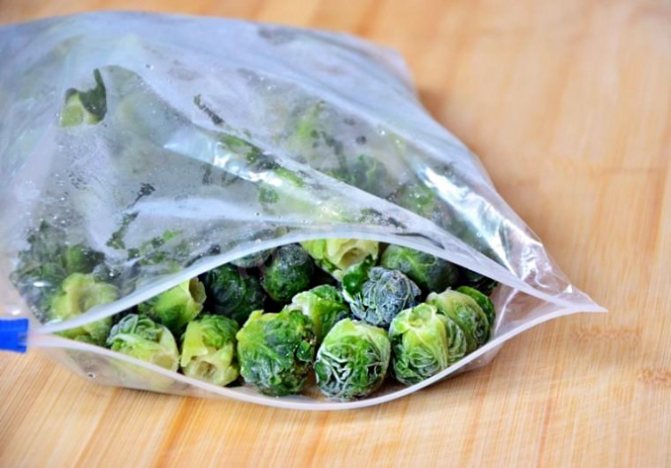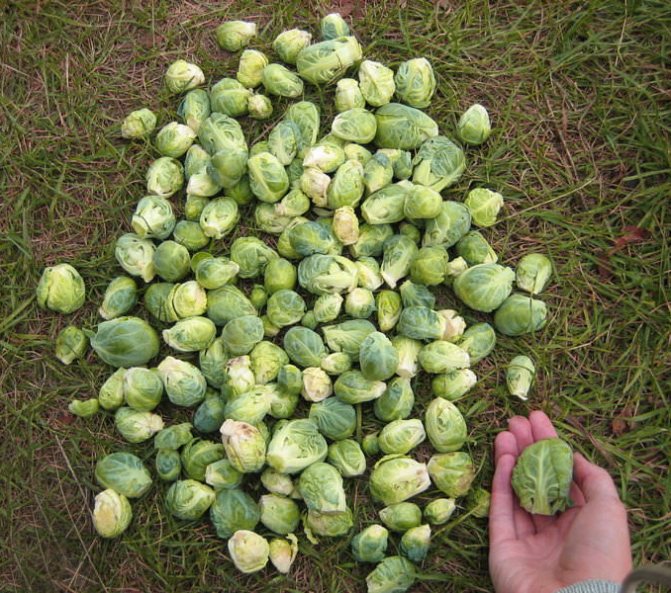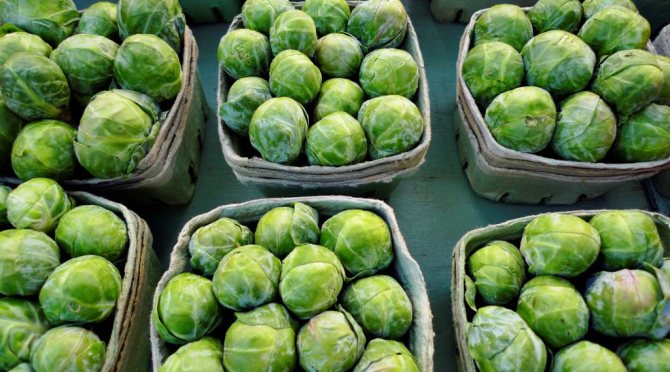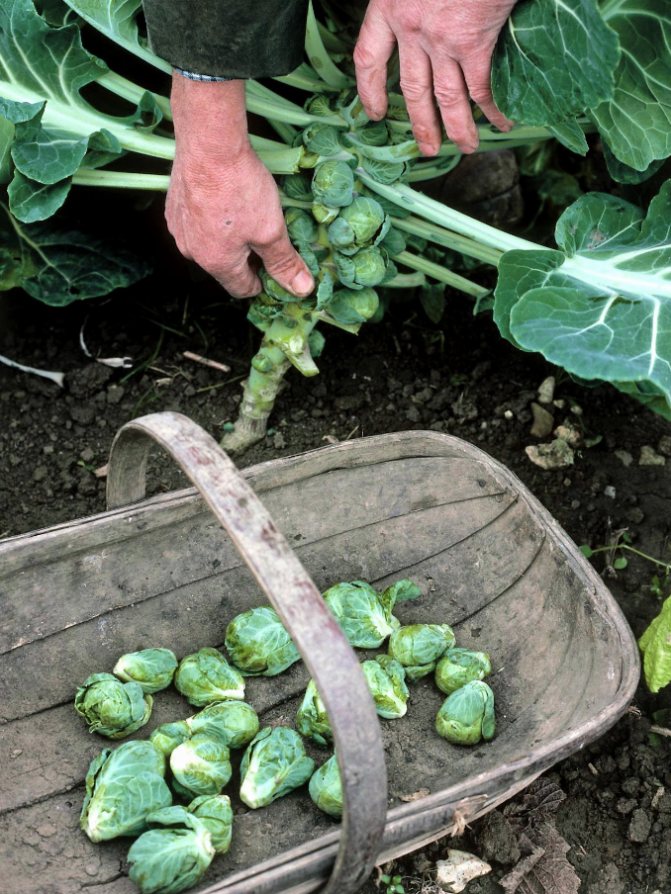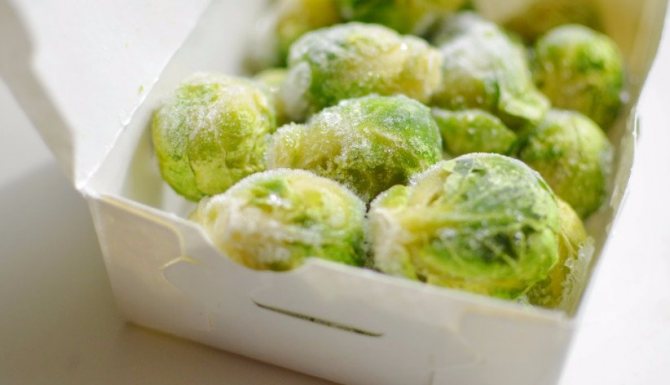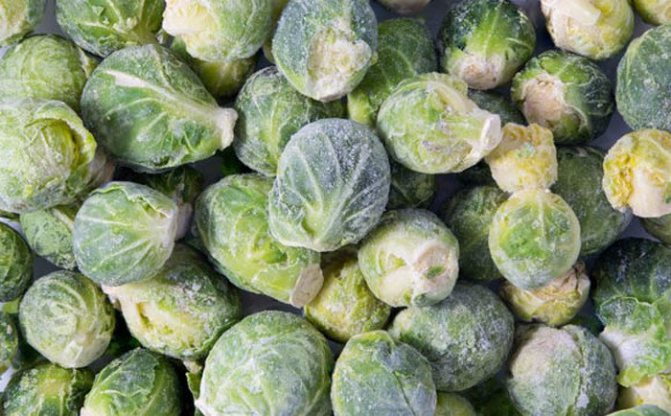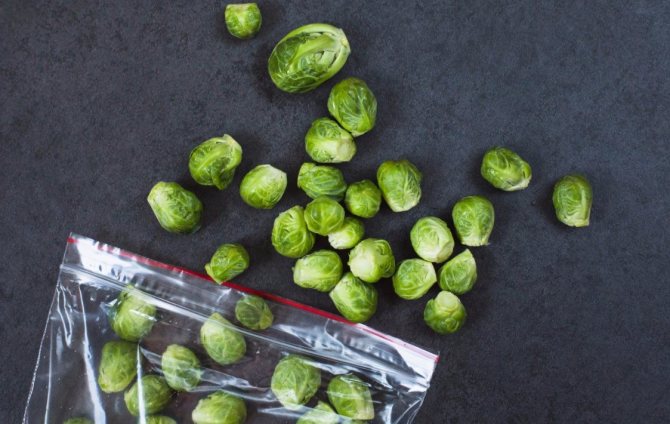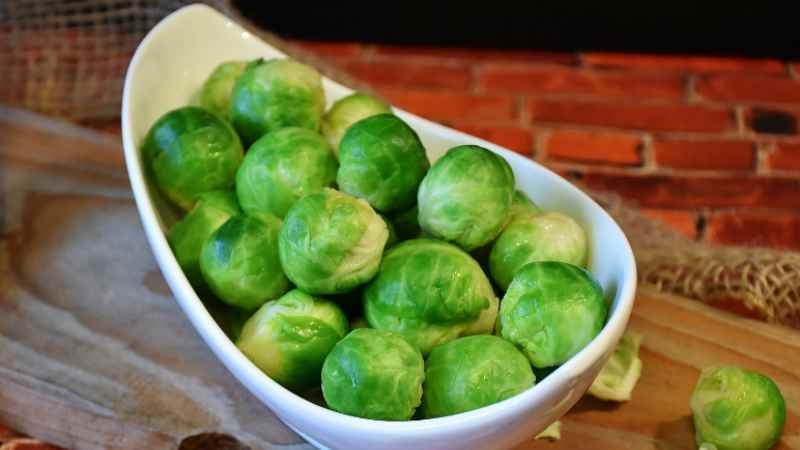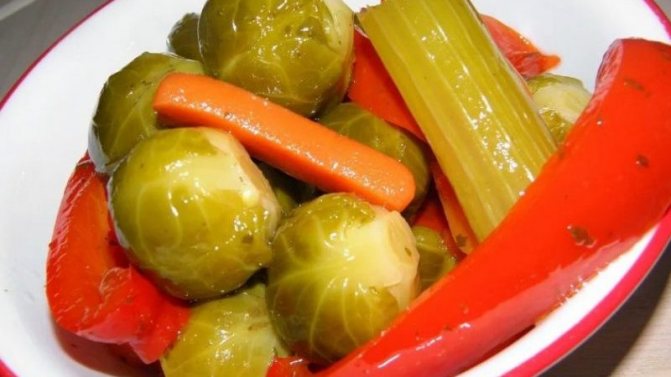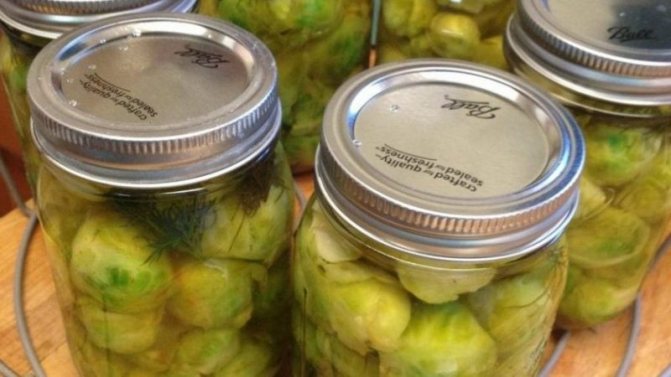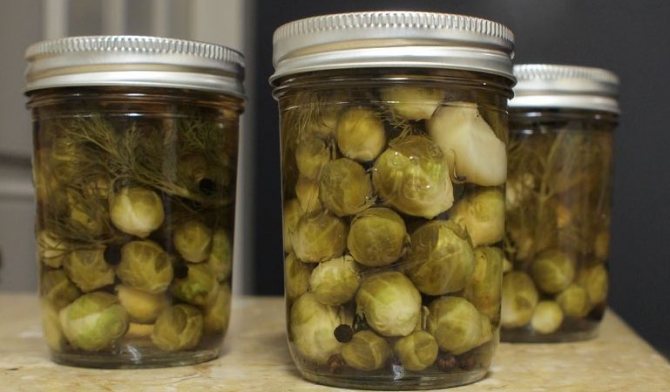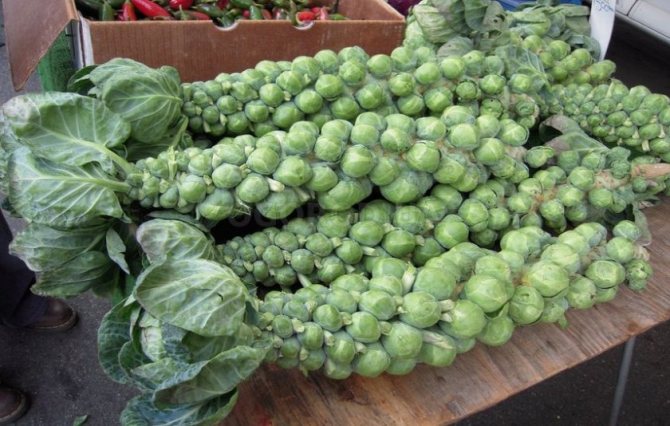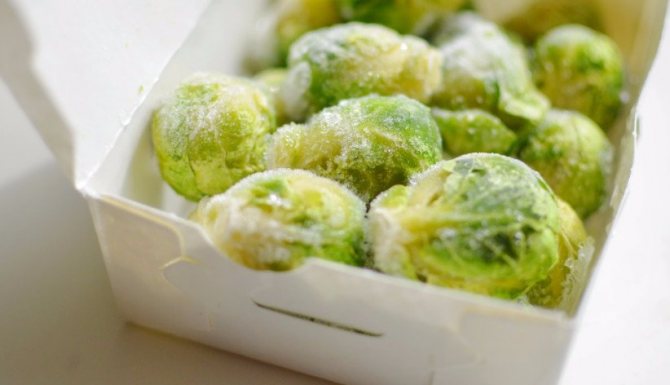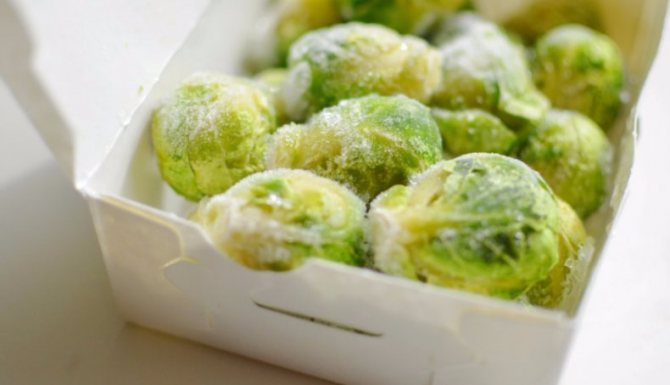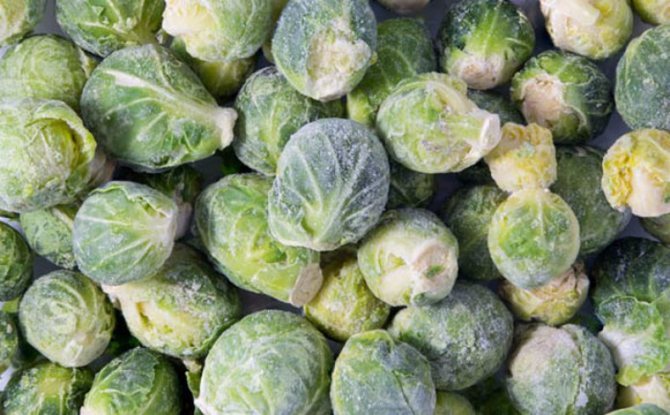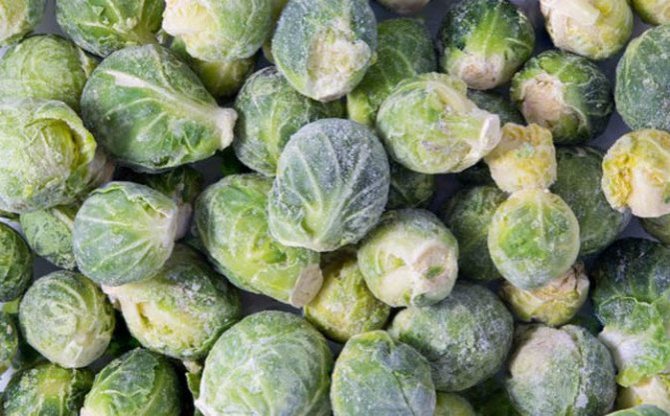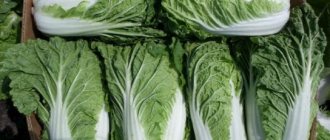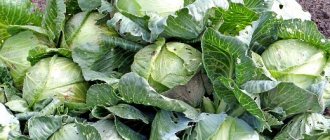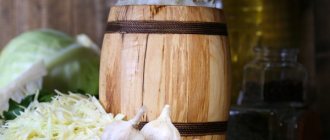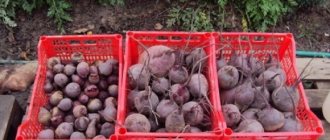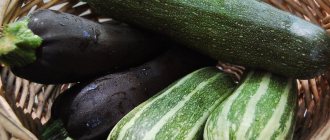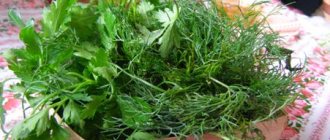Vegetables and mushrooms
The Latin name for this popular vegetable is Brassica oleracea var. gemmifera. It was bred in Belgium and got its name from Brussels breeders. Cabbage has become widespread in Europe and especially in Great Britain. It is rich in vitamin C, iron, iodine and contains up to 5% vegetable protein. Seedlings are planted in the second half of April. The crop is harvested from October until late autumn. The duration of its storage depends on the correctly selected variety and the time of collection. This is a rather thermophilic plant, therefore, it is not necessary to allow picking up heads of cabbage during the frost period. For our latitudes, special cold-resistant and high-yielding varieties have been bred. These are Rosella, Groginger, Casio, Corset, Machuga, Hornet, Curl. The highest-yielding variety is Hercules.
Stew is made from this vegetable, added to soups and used as a separate side dish.
How much Brussels sprouts are stored
- It can stay in the vegetable compartment for 1 month.
- In a cellar or cold basement, the shelf life is up to 6 months.
- The heads of cabbage will lie in the freezer for 12 months.
Choosing a variety for storage
The best varieties for the middle regions of the Russian Federation are varieties with an early ripening period. Brussels sprouts have a long growing season. If you plant late varieties, then they will not have time to tie heads and allow them to ripen for harvest.
A feature of Brussels sprouts is frost resistance. Frosts down to -8 ° C are not dangerous for her. Moreover, at such a low temperature, the heads of cabbage continue to grow and ripen. The taste of cabbage harvested after frost is much better than that harvested in early autumn.
Harvest time starts at the end of October. If weather permits, it can be postponed until mid-November.
Ripening terms
The main advantage in the cultivation of Brussels sprouts is its simplicity: it does not need additional fertilization, it does not need to be watered and hilled often.
When choosing a variety, you need to take into account the growing conditions - not throughout the entire territory of our country, this culture has time to mature before the onset of cold weather, the best choice for regions with moderate climatic conditions will be early varieties.
However, there are certain signs of the ripeness of the crop, characteristic of all species. Let's try to understand the difficult question of when to pick Brussels sprouts.
With the onset of autumn, many gardeners ask themselves two main questions - when does cabbage ripen and when to cut off the grown crop? Heads of cabbage ripen in about 12 - 14 weeks after the seedlings are planted in the ground. You can take your time with harvesting and leave the crop in the garden until frost: Brussels sprouts are not afraid of low temperatures, they feel good, even if the arrow on the thermometer drops to -7 ° C, and under the influence of cold they acquire excellent taste.
Its distinctive feature is the uneven ripening. So, the first heads of cabbage can be cut in the last days of September, and the latter - until late autumn. Most often, the lower ones are cut, and as they grow and ripen, the turn comes to the upper ones.
In order to determine the maturity of the heads, you need to pay attention to the lower leaves: if they are completely yellow (and in this case they must be removed), then this is a clear signal that it is time to act. Most often, the first harvest can be started in the last days of September.
After removing the first batch, you need to monitor the condition of the leaves on the bush. As soon as they turn yellow, this will be a signal that the second batch is ripe. Most often, this interval is from 7 to 10 days.
Storage preparation
There are several ways to collect heads of cabbage:
- cut with a sharp knife from the stem;
- cut along with the stem, leaving a small leg up to 5 cm long;
- dig up along with the roots.
When cutting fruit from the trunk, it is best to do this collection in three stages. First, the lower, ripe heads of cabbage are cut off. Then they collect the averages. The upper ones, at the very top, are ripped off last. This increases the total weight of the crop, because the remaining upper heads receive more nutrients, quickly increase in size and ripen.
Heads of cabbage, suitable for storage, should be at least 3 cm in diameter, have a uniform color, glossy shine. Each fork should be tight. Loose ones do not have keeping quality and dry quickly.
If the heads of Brussels sprouts are left for storage on the stem, then all the leaves are cut off, except for the top few.
The ways
Collect and store Brussels sprouts following the rules and recommendations of experienced vegetable growers and gardeners. There are several ways to help preserve the vegetable until spring comes.
Keeping fresh in winter
Most summer residents store cabbage in the cellars in winter. To do this, use boxes, dropping it into the sand or hanging it from the ceiling. Important points:
- Indispensable conditions are the temperature regime in the cellar from 0 to +4 degrees, and the humidity level is 90%;
- Heads of cabbage cut from the stem are kept in boxes;
- In no case should you wash the cabbage. Place the forks tightly to reduce moisture evaporation;
- Put paper or cardboard on top. Do not close the box tightly to avoid decay of the cabbage. You can store from two to three months;
- To save space in the cellar, you can hang the cabbage from the ceiling with the roots up. At a high level of humidity, it is necessary to wrap the stem in cellophane, leaving a small gap. When condensation collects inside the bag, you need to change it. If this rule is not followed, the heads of cabbage will rot.
Freezing
When frozen, Brussels sprouts will not lose their beneficial properties and will last for a long time.
Before freezing cabbage, you need to prepare:
- Choose ripe heads of cabbage, without mechanical damage;
- Cover them with cold salted water for 15 minutes to get rid of insects;
- Rinse under running water;
- Dip the cabbage in boiling water for five minutes;
- Chill in ice water;
- Pat dry with a paper towel.
Freeze in plastic bags, which must be marked with the date of freezing.
Video tutorial:
https://youtu.be/0odb5QTN6DY
Pickling
How to marinate:
- Cabbage is cut from bushes, washed, cut into pieces and filled in glass jars;
- Prepare the marinade (per liter of water add 30 ml of 9% vinegar, 2 tsp sugar, 1 tsp salt, a pinch of ground black pepper);
- Put the marinade on the fire;
- As soon as it boils, it needs to be poured into jars and pasteurized for another 20-25 minutes.
Salting
You can also try fermenting cabbage for the winter. To do this, the heads of cabbage must be washed and poured over with cold water for an hour. Then blanch it in boiling water for about 3 minutes. After blanching, arrange the cabbage in jars and cover with hot salted water.
How to remove bitterness from cabbage:
https://youtu.be/gysbTto2Qq0
Storage method in a cellar or basement
In the basement in winter, Brussels sprouts can be stored in boxes, dug in the sand, or suspended from the ceiling. It is important that the temperature in the basement is kept between 0 ° C and 4 ° C and the humidity is around 90%.
For storage in boxes, the heads of cabbage are carefully cut from the stem, being careful not to damage them. There is no need to wash, because the top leaves are covered with a thin wax layer, which has a protective function. It is important to lay them tightly to each other, so less moisture evaporates. It is better to cover the top with cardboard or several layers of thick paper. Do not close the drawer tightly, because this can lead to rotting of vegetables. Shelf life in boxes is 2 to 3 months.

In the cellar, cabbage can not only be stored, but also allowed to ripen. For this method, the heads are left on the stem. If it turned out to carefully dig up the stems with roots, then this is good. If at the time of harvesting the ground is already frozen, then you can cut off the stem, keeping the leg about 5 cm.
A thick layer of sand is poured onto the floor of the cellar, the stems are dropped into it to a depth of 3-4 cm. It is important that the sand is constantly wet. When drying, spray it with water. At a temperature of about 4 ° C, in the dark, cabbage ripens and lasts up to 5 months.
To save space in the cellar, cabbage can be hung from the ceiling, roots up. If the air is not humid enough, the suspended stem can be wrapped in cellophane, but not tightly. It is important that there is a gap between the heads of cabbage and cellophane. No need to seal from below. If condensation collects under the shelter, the polyethylene must be removed and replaced with a new one. Otherwise, the vegetables will start to rot.
Fundamental rules
Brussels sprouts are high yielding crops and are extremely beneficial for the human body. Therefore, it is necessary to preserve the grown crop in order to get everything useful from this valuable vegetable in the winter. This requires:
- Harvesting cabbage is the last thing to do, since all its varieties are mostly late-ripening;
- This cabbage is quite cold-resistant, so you shouldn't be afraid of the first frost. With the onset of cold weather, it will not deteriorate, but will only acquire additional taste;
- But if severe frosts hit ahead of time, it is worth pruning unripe cabbage bushes at the root and placing them in a warm place, digging them into a container with sand. Do not forget about regular watering until the cabbage is fully ripe.
Storing at home in the refrigerator
Storing Brussels sprouts in the refrigerator requires plastic bags. Small holes must be made in them for air to enter, otherwise condensation will collect inside, and the heads of cabbage will begin to rot. It is better to put in bags in portions so that, if necessary, do not violate the integrity of the large package.


If the temperature in the refrigerator is 10 ° C, then cabbage can be stored for about two months. If the temperature does not exceed 5 ° C, the shelf life will last up to 3.5 months.
For storage in the refrigerator, damaged heads must be discarded. They are not stored for a long time. Moreover, neighboring heads of cabbage can begin to deteriorate from them.
Brussels sprouts salad


Brussels sprouts salad
Ingredients required:
- Brussels sprouts - 200 g (half a pack),
- carrots - one thing,
- pink salmon, trout or other fish (canned food) - one can,
- green peas (canned) or beans (in their own juice) - one can,
- mayonnaise, tomato paste or olive oil - to taste,
- wine vinegar or dry wine - one spoon.
Cooking process:
- Boil the cabbage for 15 minutes (until tender), dip in cold water for a minute, cut each head of cabbage into four parts, sprinkle with vinegar.
- Boil carrots, cut into cubes.
- Open the canned food, and divide each piece of fish into several parts (by 8-10). You can simply grind the fish with a fork. Do not pour out the oil.
- Combine kale, carrots and green peas.
- Mix vegetables with fish.
- Season with canned oil by mixing it with a little olive oil, mayonnaise or tomato paste. A harmonious taste is obtained by adding a spoonful of pasta and two tablespoons of mayonnaise to the canned oil. With olive oil (no mayonnaise and pasta), the taste will be more delicate.
Freezing
Before storing Brussels sprouts for storage in the freezer, it must be prepared:
- we select high-quality forks, ripe and without damage;
- put it in salt water for 15 minutes so that all insects that may be inside float to the surface;
- rinse in cool water;
- dipped in boiling water for 5 minutes;
- cool in ice water;
- dry.
For freezing, we pack in plastic bags: one bag - one dish. You do not need to make holes in the bags. But it is better to stick labels with the name of the product, its weight and the date of freezing.
Salt, pickle. Delicious recipes
This culture preserves vitamins and microelements not only when frozen and stored in a cellar, but also by salting. In this form, it still has excellent taste, because salted heads of cabbage are an excellent appetizer to any table. Let's look at a few recipes for the winter.
How to salt. Recipe
Required Ingredients:
- 1 kg of cabbage;
- 1 liter of water;
- 2 tablespoons of salt;
- 3 - 4 carrots;
- 2 tablespoons of sugar;
- 2 bay leaves;
- a bunch of greens (to taste);
- peppercorns (to taste).
Cooking method:
You should start with preparation - the carrots need to be washed, peeled and grated. The cabbage should be carefully sorted out, the limp leaves should be removed. If the heads of cabbage are large, it is desirable to divide them in half. Smaller ones are allowed to be salted without dividing.
The next stage consists in mixing cabbage and carrots in a deep container (it is more advisable to choose a wooden container for pickling cabbage), at the end all the necessary spices are added.
In the meantime, prepare the brine: you need to boil water in a saucepan, add salt and sugar. Once the brine is ready, you can pour in all the ingredients. If salting is done in a wooden container, then cover it with a cloth and put something heavy on top.
In this method, it is very important to completely immerse the heads of cabbage in the brine, so it is better to calculate the required amount in advance. Such preparation will allow you to quickly and effortlessly preserve the cabbage for a long time.
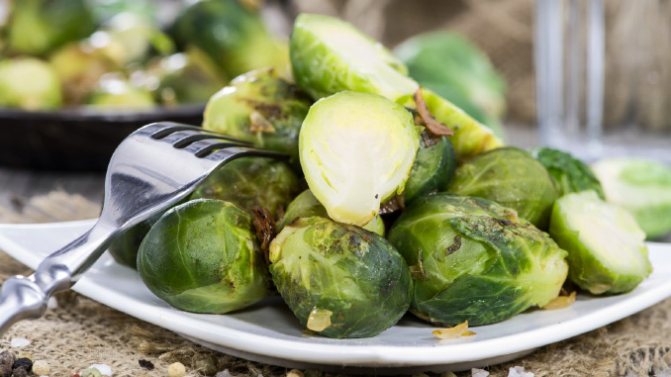

How to pickle. Recipe
Pickled cabbage has a special taste. We bring to your attention a very tasty recipe.
Required Ingredients:
- 1 kg of Brussels sprouts;
- 2 - 3 carrots;
- 2 cloves of garlic;
- 3 tbsp. tablespoons of vegetable oil;
- 4 tbsp. tablespoons of vinegar;
- 4 tbsp. tablespoons of sugar;
- half st. tablespoons of salt.
Cooking method:
Sort the cabbage, rinse with plenty of water, remove dry leaves. Divide each head of cabbage (if they are not too small) into 2 parts. Peel the carrots and cut into rings, rub the garlic through a fine grater.
Bring the water to a boil, toss in the prepared cabbage and carrots. Let the vegetables boil for a few minutes, then remove them from the pan, add the garlic there and place all the vegetables in the jar.
Add the necessary spices to the vegetable broth, bring to a boil again and pour the vegetables into the jar. When the water temperature reaches room temperature, lower the jar into the basement for at least 2 days.
Conservation recipe
Required Ingredients:
- 3 kg of Brussels sprouts;
- half a liter of water;
- 200 ml of table vinegar;
- 3 tbsp. tablespoons of sugar;
- a tablespoon of salt;
- 3 g horseradish root;
- 3 black currant leaves;
- 5 black peppercorns.
Cooking method:
First of all, you need to prepare the marinade - all the specified spices are thrown into the boiling water, and at the very end, vinegar is added.
The heads of cabbage are prepared: they are washed, sorted out, if necessary, divided into 2 parts. After the preparatory part, they are filled with water, put on the fire and boiled for 5 - 7 minutes. after boiling.
Then the boiled cabbage is taken out of the pan, placed in pre-prepared jars, poured with marinade and rolled up with lids. Do not forget that sterilization of cans is fundamentally important in the preservation process.
Swirling should be done without the presence of air bubbles in the cans. They must be removed without fail and the brine added to the very edges.
A cellar or refrigerator is perfect for storing canned cabbage.
Brussels sprouts are low in calories, they are rightfully considered a dietary vegetable. Moreover, it contains a huge amount of useful substances that prevent the occurrence of many diseases, including cancer. It is great for all types of heat treatment, but it is important not to overdo the cooking time, because heads of cabbage will quickly lose all vitamins and minerals.
Follow the recommendations given in the article on the rules for harvesting and storing crops in the winter, and then you will be able to preserve the excellent taste and useful properties of this crop.
Thanks for attention!
IMPORTANT! * when copying article materials, be sure to indicate an active link to the source:
If you liked the article - like it and leave your comment below. Your opinion is important to us!
Useful Tips
If you want to store Brussels sprouts in the basement, you must periodically check the humidity of the air, ventilate, and keep the sand wet.
In the refrigerator, it is important to ensure that the cabbage heads do not start to deteriorate. If one starts to rot, it can infect others. If a lot of condensation collects in the bag, then you should change the packaging and dry the forks.
Share your winter storage experience with Brussels sprouts. How long have you managed to keep it? Maybe you have your own method? This is interesting not only for us, but also for other readers.
Properties and benefits of Brussels sprouts
The content of vitamin C in Brussels sprouts is 3-5 times higher than in all other types of cabbage, it is almost the same as in black currant berries. It also contains 2-3 times more other vitamins than any other cabbage. The riboflavin content is almost at the level of milk and dairy products. Nutritionally valuable raw protein in Brussels sprouts is 4-5 times more than in white cabbage, and also 2-3 times more than in cauliflower.
Cabbage is a dietary food. It is especially useful for the elderly and children. Brussels sprouts are recommended as a dietary product for those who suffer from diseases of the cardiovascular system.
On a special account is the juice of Brussels sprouts, which helps to restore the work of the pancreas and is considered very useful for patients with diabetes mellitus. Also, the beneficial properties of Brussels sprouts juice include its fortifying, anti-inflammatory, immunostimulating, anti-infectious, hematopoietic, anti-atherosclerotic, anti-scorbutic, anti-cancer, anti-toxic effect. It also affects the human body as a mild laxative, as well as a choleretic, diuretic and expectorant. The high content of mineral salts, and, above all, potassium salts, make the juice of Brussels sprouts one of the very important components in the diet of hypertensive patients and people suffering from arrhythmias.Due to its healing qualities, this juice is included in the menu of cancer patients.
The ability of Brussels sprouts to stimulate wound healing is actively used in the recovery period after surgery. This is also facilitated by the general strengthening effect of cabbage on the human body and its ability to increase immunity. It is interesting that the broth prepared from this cabbage is in no way inferior to the very healthy chicken broth in its nutritional qualities and nutritional value.
Contraindications include, perhaps, only the fact that juice from Brussels sprouts should be taken with caution by those who have increased gastric acidity. ...

